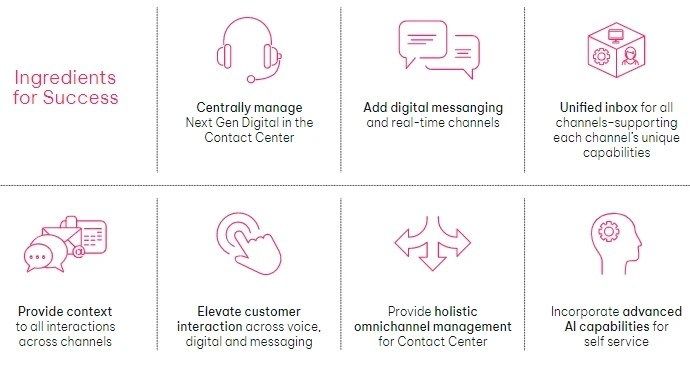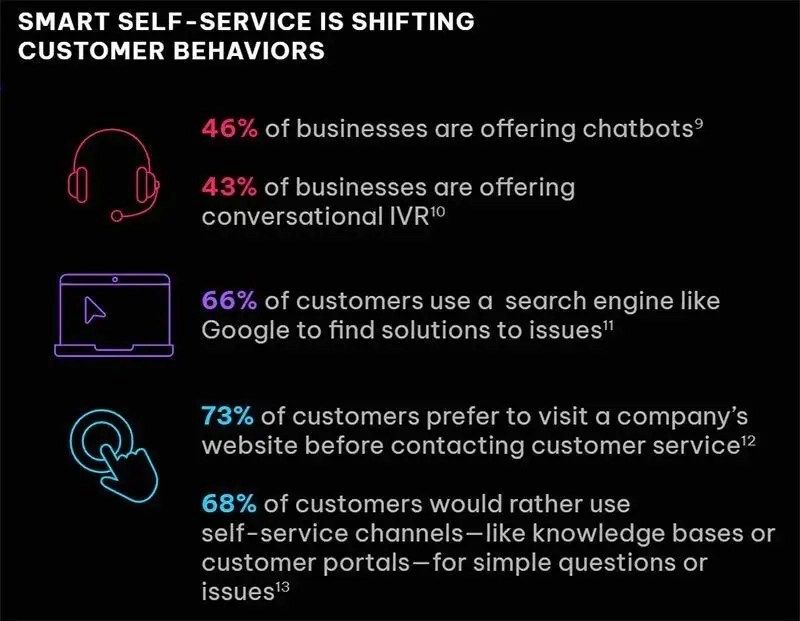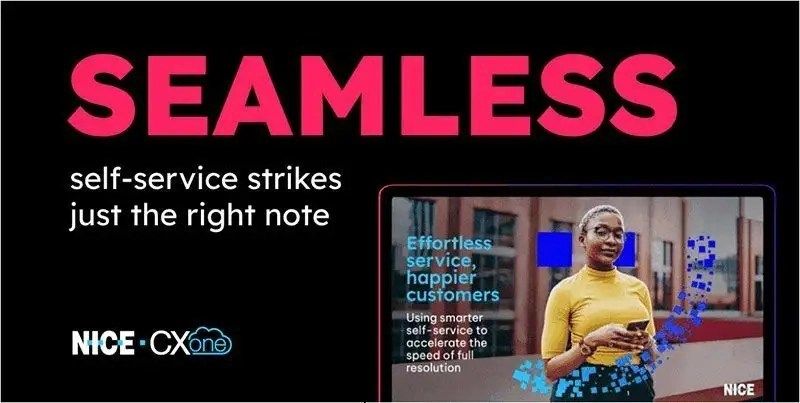
What qualifies as “smart” self-service?

- Proactive engagement on web and mobile
- Knowledge management
Approach self-service with a data-driven strategy in mind
Artificial intelligence (AI) is the backbone of smart self-service. It automates self-service and delivers the ability to deploy across multiple platforms and channels, allowing customers to self-serve through their channel of choice.Sophisticated AI can analyze voice and text interactions and then extract historical, conversational data from these conversations. From there, you’ll be able to break down each interaction into easily interpreted metrics to help you visualize the customer journey. From there, you can determine where self-service is most appropriate and effective. This generates the most complete and precise automation workflows and gives you the holistic view needed to efficiently map customer journeys.But your self-service strategy should extend beyond reading numerical data on a chart. To be effective, you should critically evaluate each step of the customer journey, paying particular attention to touchpoints where friction occurs (abandoned interactions, stalled resolutions, bottlenecks). What’s the result of forming such a strategy? Containment. Peak digital fluency. A deeper, more accurate understanding of customer intent and communication.The list goes on, but we think you get the picture.Smart self-service is only as good as its foundational tech allows
A large part of intelligent self-service boils down to the intuition of the applications and technology your contact center uses.“Self-service channels often lack the technologies needed to meet customers where they want in the digital world.”Get the report
- From the Aberdeen report, “Reimagining the Power of Self-Service: How to Deliver CX to the Digital Doorstep”
Is your self-service smart enough?
Self-assessment time. Consider your own company’s self-service solutions. When looking through the lens of elevated CX, how do you think they perform? What’s working? What could use some improvement?According to Salesforce, 65% of customers prefer self-service for simple matters; however, based on research NiCE conducted, only 15% of consumers are satisfied with the self-service tools they’re offered nowadays. Why is that?The truth is that many companies either haven’t implemented smarter self-service within their operations or haven’t effectively built a smart-self service system with the end user in mind. The ability to evaluate customer expectations across journey touchpoints ensures you’re delivering the best experience possible, and smart self-service applications can help provide those insights. Below is the perfect formula to help you do just that.
Read moreProviding self-service to customers isn’t just about its availability to customers. What truly makes a difference is how, when, and where you offer self-service to them. Smart self-service meets customers at exactly the right place at the right time with the right answers, so anticipating needs is essential to an ideal self-service experience.“Companies with the best self-service systems intentionally place them in spots across the customer’s journey that are most conducive to the customer already wanting to help themselves.”
- From the NiCE CXone eBook, “Effortless service, happier customers: Using smarter self-service to accelerate the speed of full resolution”
Achieving the ideal full-resolution path with self-service
When customers come to your website looking for answers, or to complete a task on their own, they want the experience to be easy, straightforward, and customized to their needs. So how do you gauge if your smart self-service resolutions are hitting the mark and producing results? It’s hard to go wrong so long as you adhere to the following guidelines:- Keep it fast
- Keep it frictionless
- Keep it personalized

Help customers and agents help themselves
When you focus on reducing friction along the digital journey, you not only improve your customer experience—you will discover weaknesses in your technology and strategies. You’ll also identify gaps in agent training that, when remedied, can reduce friction as well.And speaking of agents—when you provide your agents with access to up-to-date knowledge and content, it helps them help customers more efficiently. Agents should have the ability to help themselves just as much as customers should be able to self-serve. Though mutually exclusive, this benefits both parties if an instance of self-service must be escalated to a well-prepared live agent.Smart self-service isn’t a ‘nice-to-have’; it’s a ‘must-have’
When customers are given the ability to quickly self-solve their own issues, without the need to escalate to a live agent, they come away happy from the experience with your organization. When agents are free to tackle more complex, challenging, and time-consuming interactions and problems because simpler issues are handled by smart self-service, their own feelings of fulfillment and satisfaction will increase.When it comes to understanding and implementing smart self-service in your own organization, there’s a lot more where this came from. For more insight into smart self-service and crafting a strategy that delivers exceptional CX, read the eBook, Effortless service, happier customers: Using smarter self-service to accelerate the speed of full resolution.




